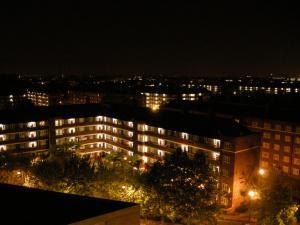 I’m Shepherd’s Bush born and bred and have long felt pride in the fact that the White City estate has been represented by a Black councillor as long as I can remember.
I’m Shepherd’s Bush born and bred and have long felt pride in the fact that the White City estate has been represented by a Black councillor as long as I can remember.
Ron Browne held the ward for many years from the early 1980′s when I was still at school.
Browne served as chairman of the housing committee for a long time and can take a large slice of credit for the renovation of White City, next to the BBC’s Wood Lane offices.
Browne, who was awarded an MBE, featured in a book of Black councillors published in the mid-1980′s with the help of the late Bernie Grant then leader of Haringey Council.
I believe I’m correct in asserting that the sprawling estate has always been represented by at least one Black councillor continually right up until the present day. That is now about to change as a result of the sad death of Jean Campbell. All the mainstream parties have selected white candidates for the byelection this Labour stronghold.
Of course the best candidate should always be selected regardless of color or background. Yet in a borough with a BAME population over 28 percent it speaks volumes that there are presently only two black councillor in Hammersmith and Fulham and no Asians out of 46 elected members. That population percentage figure is nearer 37 for the Wormholt and White City ward on 2001 census figures, and is undoubtedly much higher now.
If good BAME candidates are not available for selection all political parties need to ask themselves questions about their links and relationships with the borough’s diverse communities.
Hammersmith and Fulham has never been particularly well-represented by ethnicity on the council, including during the 1990s when I served one term as a Labour councillor there. But even then it was almost taken as read that White City would return at least one Black councillor.
The scarcity of Black councillors in this borough is symptomatic of a wider picture across local government, where rates of Black representation have remained static at around four percent.
Council chambers are falling further and further behind Parliament, as I pointed out in an article for the Local Government Association in 2001. To quote myself (!):
“Nelson Mandela was still in jail, Mikhail Gorbachev was leader of the USSR, and Bernie Grant and Linda Bellos led Haringey and Lambeth councils. Yes, the golden age for black and minority ethnic (BAME) councillors was that long ago – the mid-1980s. Over two decades later, local government remains as white and old as ever.
“In London, many inner-city authorities have less councillors of color than they did in the 1980s. The proportion of black and Asian councillors has been virtually unchanged since 1997 – just four per cent – while the UK minority ethnic population is projected to almost double from 7.5 per cent (2001) to 14.5 per cent by 2016.
“White councillors are five times more likely to be group leader, and while 21 per cent of white councillors make it to the executive or higher, just 14 per cent of BAMEs reach those heights.
“As a founding member of the National Association of Black, Asian and Ethnic Minority Councillors, I discovered many members who said they felt isolated in their party groups. Race was frequently cited as a hidden factor in internal disciplinary procedures.”
Last June I wrote on this blog that Birmingham, Glasgow, Liverpool, Leeds, Sheffield, Edinburgh, Bristol, Manchester, Leicester and Coventry are all without a single black councillor in their cabinets or executives.
It is crucially important that local government continue to focus on the un-representative nature of local democracy. While the natural approach is to look holistically at the wider picture across Britain we must not shy away from shining the spotlight on individual town halls with high Black populations but few Black councillors.
Even the ward picture, in places like White City, matter. There may not have been strong Black members putting themselves forward for election, but the questions have to be ‘why?’ and ‘what can we do about it?’
By Lester Holloway @brolezholloway
